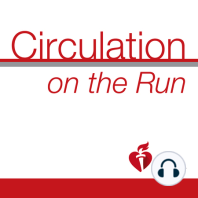16 min listen
Circulation October 26, 2021 Issue
ratings:
Length:
27 minutes
Released:
Oct 25, 2021
Format:
Podcast episode
Description
Please join author Jonathan Newman and Associate Editor Sandeep Das as they discuss the article "Outcomes of Participants With Diabetes in the ISCHEMIA Trials." Dr. Carolyn Lam: Welcome to circulation on the run, your weekly podcast, summary, and backstage pass to the journal and its editors. We're your co-hosts; I'm Dr. Carolyn Lam, Associate Editor from the National Heart Center and Duke National University of Singapore. Dr. Greg Hundley: And I'm Dr. Greg Hundley, Associate Editor, Director of the Pauley Heart Center at VCU health in Richmond, Virginia. Well, Carolyn, this week's feature, a couple of weeks ago, we had that feature forum on the ischemia trial. Now we're going to explore some of the outcomes in patients with diabetes, from the ischemia trial in the feature discussion today. But, before we get to that, let's grab a cup of coffee and start in on some of the other articles in this issue. So, how about if I go first, this time? This particular paper, Carolyn, we're going to start on one of your topics. I know you're a fan of diet related interventions. So high intake of added sugar is linked to weight gain and cardio-metabolic risk. And in 2018, the U S National Salt and Sugar Reduction Initiative proposed government supported voluntary national sugar reduction targets. Dr. Greg Hundley: This intervention's potential health and equity impacts and cost effectiveness are unclear. And so Carolyn, these authors, led by Dr. Renata Micha from Tufts University, incorporated a validated micro-simulation model - CVD Predict coded in C++, and used it to estimate incremental changes in type two diabetes, cardiovascular disease, quality adjusted life years, cost and cost effectiveness of this national policy. The model was run at the individual level and the model incorporated national demographic and dietary data from the National Health and Nutrition Examination Survey across three cycles spanning from 2011 to 2016, added sugar related diseases from meta-analysis and policy costs and health-related costs from established sources and a simulated nationally representative us population was created and followed until age 100 years or death with 2019 as the year of intervention start and findings were evaluated over 10 years and a lifetime from healthcare and societal perspectives. Dr. Carolyn Lam: Ooooh, You so got my attention, Greg, a very important topic and so, what did they find? Dr. Greg Hundley: Right, Carolyn. So achieving the NSRI sugar reduction targets could prevent 2.48 million cardiovascular death related events, 0.5 million cardiovascular disease deaths, and three quarters of a million diabetes cases, gain 6.7 million quality adjusted life years, and save $160.8 billion in net cost from a societal perspective over a lifetime. The policy became cost-effective, defined as less than $150,000 for quality adjusted life years at six years and highly cost-effective at seven years with a cost savings noted at nine years. And therefore, Carolyn, implementing and achieving the NSSRI sugar reformation targets could generate substantial health gains, equity gains, and cost savings. Dr. Carolyn Lam: Wow, thanks Greg. So, moving from a very publicly health focused paper to this paper that really focuses on hypoplastic left heart syndrome with very, very scientifically significant findings. Now, first, we know hypoplastic left heart syndrome is the most common and severe manifestation within the spectrum of left ventricular outflow tract obstruction defects occurring in association with ventricular hypoplasia. The pathogenesis is unknown, but hemodynamic disturbances are assumed to play a prominent role. Authors led by Doctors Moretti and Laugwitz from Technical University of Munich in Germany, as well as Dr. Gruber from Yale University School of Medicine, and their colleagues combined whole exome sequencing of parent offspring, trios, transcriptome profiling of cardiomyocytes from ventricular biopsies and immuno-pluripotent st
Released:
Oct 25, 2021
Format:
Podcast episode
Titles in the series (100)
Circulation August 30, 2016 Issue: Circulation Weekly: Your Weekly Summary & Backstage Pass To The Journal by Circulation on the Run
